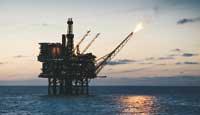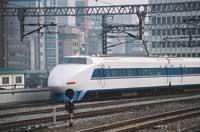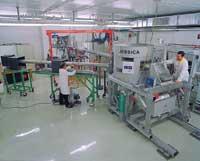ESS, great neutron flow
The European Space Source (European Spallation Source, ESS) is the name of the European project. Although the project is from the European Science Foundation (European Science Foundation), the ESS has the support of the countries of the European Union. In short, it is a plant for obtaining neutrons and research of materials.
Tradition of tradition

The most common system for obtaining neutrons is nuclear reactions. Conventional nuclear reactors use radioactive uranium 235 for fuel. This isotope is usually mixed with the most abundant non-radioactive uranium 238 isotope. This means that to be a nuclear reactor that does the job well, uranium must be enriched much so that it has the maximum content in the uranium isotope 235. In normal nuclear fission reactions, uranium atoms are broken, divided into two lighter atoms, the other two more… and neutrons are also released. These neutrons that are released - after losing the air- collide inside the fuel nucleus with other uranium nuclei, break again and form lighter nuclei and neutrons… it is the basis of the chain reaction, the nuclear fission.
To obtain neutrons, nuclear reactors can be used, and they have been used, but they cause more than one problem. One of them is the nature of the reaction, the character of string, since it is a chain reaction. Therefore, this reaction must remain in some way, since if it cannot be stopped, a huge disaster can occur. The nuclear reactors, besides producing the reaction, have this function. In these typical reactions a lot of neutrons is produced, but more important is the amount of energy that is generated by fission effect, by dividing the nuclei into smaller nuclei. For this reason, most of the nuclear reactors have been built to obtain energy, to transform that energy that is generated from fission into thermal, electrical, etc.
However, nuclear research reactors have also been carried out, that is, they are adapted to the obtaining of neutrons instead of energy. This technique is good for getting neutrons, but it has its limitations. On the one hand, it must be taken into account, at least the researchers take it, that if the reactor is not used for anything else to obtain neutrons, much energy is wasted. On the other hand, the problem of radioactivity, that of radioactive waste, since today no one knows what to do to solve the problem of radioactive waste.
Breaking tradition
In view of the difficulties presented by nuclear reactors in general, even those adapted to obtain neutrons, it is not surprising that the number of nuclear reactors decreases. Therefore, in this century that has just begun, it doesn't make much sense to think that if you have to do something to get neutrons, something has to be based on fission techniques.

In contrast to the techniques of fission there are, among others, sources of space. There is a substantial difference between space and nuclear reactions: in spacing techniques the nuclei of atoms are not broken. Because the nuclei do not break, there is no fission and when there is no fission reaction, there is no radioactivity. The sources of expansion are based on protons. These protons are sent at high speed on accelerators against heavy metals such as mercury or lead. Because these metals weigh many neutrons, when hitting the protons the neutrons are excited and pass to a high energy state, but then calm with release. Neutrons are created but without breaking the nucleus. This is important because if the atomic nucleus is not broken there is no nuclear reaction and therefore there is no risk of radiation. Although gamma radiation occurs in this process, this type of radiation does not present great risks.
The non-rupture of the nucleus has more advantages than nuclear reactions. In fact, since the nuclei are not broken, the liberated energy is less than normal. Therefore, the energy used to obtain a neutron by backbone is much lower than that used to obtain the same neutron by nuclear reactions. In this sense, the technique of space seems more sensible.
If we look for differences between both techniques, we can mention the absence of chain reaction. In nuclear reactions, once the chain reaction has begun, it is impossible to stop until the fuel is finished, while in the sources of expansion there is no problem. These techniques require only the obtaining of high energy protons, for which the help of the particle accelerator is sufficient. The process can be left when you want, since you just stop sending protons, you do not need to control the chain reactions or slow the speed of the neutrons.
For what neutrons?
The advantages of using the spalation technique for the use of neutrons have been reflected in the previous lines. It seems the most appropriate technique, but what are neutrons needed for? What makes it so valuable?
From the point of view of usability, the use of neutrons is understandable. When you want to know how a certain material responds or how the microscopic composition of the matter is, you need to know where the atoms are, the atomic structure, and how they move or respond. Although this is important for basic science, it can be more important for technology, since the new materials are the basis of new technologies, all areas of technology are related to the behavior of new materials. To know where atoms are located and how they move, to compare them with the characteristics of certain materials, there are dispersion techniques, in this case neutron dispersion techniques. That is, the neutrons of certain energy collide with concrete samples and what happens with the sample is investigated both during shock and after.

The particles most suitable for all are neutrons, although protons, own light, X-rays, etc. The neutrons are subatomic particles that together with the protons are found in the nucleus of the atoms. The neutrons have a particularity, they have no electric charge. Therefore, the interactions between neutrons and matter are very special, since they can penetrate much into the matter. The neutrons have other particularities: they have a magnetic moment, they have the same energy as the atoms or molecules when interacting with the matter, they have the wavelength of the interatomic distance, they are able to distinguish from the same nucleus… and these characteristics are of great value for different studies.
The dispersion of neutrons provides excellent microscopic information on the structure and dynamics of the matter. In the field of condensed matter, the contribution of neutrons has been perfect for understanding magnetism and the base of quantum. To understand plastics, proteins, polymers, fibers, liquid glass, magnets, superconductors, among others, neutron research has been very important, but it can be more important.
Project ESS
At the end of the sidewalk project, it will be 30 times more powerful than any existing source.
Today there are sources of neutrons. However, they have problems since they are less intense than conventional nuclear reactors. The ESS project aims to carry out an international cooperation project in Europe. In addition, this source is intended to have a greater flow than the existing nuclear reactors today.
The experiments that could be carried out in ESS would correspond to a new generation and could answer numerous questions in some of the current areas, such as superconductors and cosmology. In addition to physics, ESS would be useful in biology, chemistry, engineering, geology and medicine. Of course, also to investigate important issues that are being introduced into the industry.

At this moment the project is quite mature. However, the possibilities are different, so currently they are looking for solutions, since both the building and the experiments should be adapted. So the XXI. In anticipation of possible points of interest of research of the twentieth century, the experts gathered in Donostia-San Sebastián analyze the technical possibilities of the installation. That is, they will debate what can be the most appropriate facilities to respond to research needs. If the plans were to go well, the construction of the ESS would begin in 2004, end in 2010 and be fully operational in 2012. Germany is the country that has more possibilities to host the facilities, although there is nothing decided. In theory, at least.
From a scientific point of view, the project can have a great importance for the investigation of the structure and dynamics of materials, since ESS is a much more effective tool than the existing ones. This means that in the future, unknown lines of research can be opened. And that's important.
However, the importance of this project also has to do with the rival's project. And so far, Europe has been the leader in this line of research. If the ESS is not built, the leadership would be assumed by the United States, which are already building its own expansion source called SNS. There is no cold war, but the Americans go ahead. It is not the worst spur.





